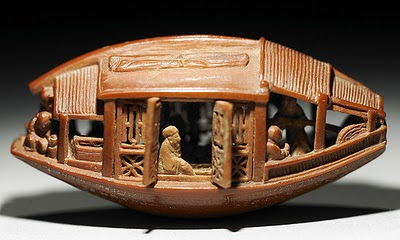A Brief History of the National Palace Museum:
Thirteen years after the founding of the Republic of China [Taiwanese History: Double Tenth Day: October 21, 2010] the last emperor Pu Ying was exiled from the Forbidden City. All cultural artifacts within the palace became the basis for the National Palace Museum in the Forbidden City. The Museum was inaugurated on October 10, 1925. The mission of the National Palace Museum was to preserve the artifacts and make them available to be seen by all citizens of the Republic of China.
In 1931 the decision was made to crate all of the objects to make them ready to move in order to protect them from falling into Japan’s hands as during the Japanese Invasion of Northeast China.
In 1948, the civil war between nationalist troops and communist troops took a turn for the worst for the Republic of China and all artifacts were evacuated to Taiwan to preserve them.
In 1965 The National Palace Museum opened in Taipei, Taiwan where it remains today. The National Palace Museum has one of the largest collections of Ancient Chinese Art in the world. It’s a world-class museum and ranks as one of the finest in the world. There are many notable pieces from the Song (960–1279), Yuan (1279-1368), Ming (1368-1644), and Qing (1644-1912) Dynasties.
Notable Artifacts
The Jadeite Cabbage
The Jadeite Cabbage was made during the Qing Dynasty as a gift for the emperor. The White and green coloring of the Jadeite was used to make this carving look like a Chinese White Cabbage. Hidden in he leaves of the cabbage are crickets. The detail of this piece is amazing, when looking closely at the cricket you can see the ridges that make the cricket’s sound on the back of the legs. The crickets represented the wish for children for the emperor. The Jadeite had a number of flaws; the artist incorporated the flaws into the design hiding them.
The Carved Olive Boat
This is small carved boat. It is the size of a small walnut and has been graved by hand in approximately 1737. If you look at the boat you can see doors that open and people who have been carved into the interior of the work. The people all have different expressions on their face. There is a text of more than 300 Chinese characters carved into the bottom of the boat.
The Peach Vase
This vase made in the Qing Dynasty is made of ceramic clay. There is beautiful artwork in glaze on the sides of the vase. It is a branch of Peach Tree containing four peaches and peach blossoms.
The museum is located at No.221 Sec.2 Zhisan Road, Taipei. It can easily be found using Taipei’s system of public transportation. The Hours of the museum are 8:30 am to 6:30 pm. General admission is $160 NTD however, disabled people and one attendant can enter for free. The museum has wheelchairs available for disabled guests. Food and souvenirs can be purchased at the museum.

Chris Banducci is a pastor and missionary in Taiwan. He has, at other times of his life, been a white-water rafter, rock climber and adventurer. He left the corporate world of Solid Waste Recycling in 1996 and went into full-time ministry, where he pioneered a church in Riverside, California for the Potter’s House Christian Fellowship and is now engaged in the same endeavor in Taoyuan City, Taiwan. He writes on the culture, religion, tradition, and day-to-day life in Taiwan. Twenty-six years of living with Muscular Dystrophy may have weakened his muscles but not his spirit.











